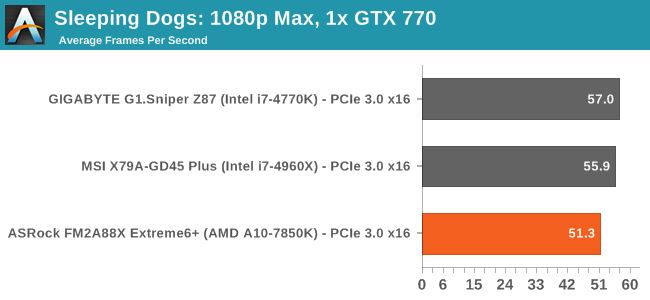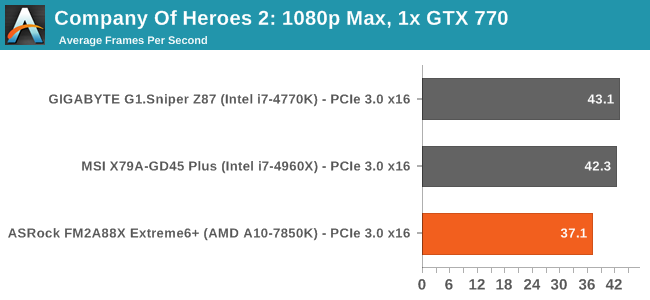ASRock FM2A88X Extreme6+ Review
by Ian Cutress on March 19, 2014 11:59 AM ESTSleeping Dogs
Sleeping Dogs is a benchmarking wet dream – a highly complex benchmark that can bring the toughest setup and high resolutions down into single figures. Having an extreme SSAO setting can do that, but at the right settings Sleeping Dogs is highly playable and enjoyable. We run the basic benchmark program laid out in the Adrenaline benchmark tool, and the Xtreme (1920x1080, Maximum) performance setting, noting down the average frame rates and the minimum frame rates.

| Sleeping Dogs, 1080p Max | ||
| NVIDIA | AMD | |
| Average Frame Rates |
|
|
| Minimum Frame Rates |
|
|
Company of Heroes 2
The final gaming benchmark is another humdinger. Company of Heroes 2 also can bring a top end GPU to its knees, even at very basic benchmark settings. To get an average 30 FPS using a normal GPU is a challenge, let alone a minimum frame rate of 30 FPS. For this benchmark I use modified versions of Ryan’s batch files at 1920x1080 on Ultra. COH2 is a little odd in that it does not scale with more GPUs.

| Company of Heroes 2, 1080p Max | ||
| NVIDIA | AMD | |
| Average Frame Rates |
|
|
| Minimum Frame Rates |
|
|












44 Comments
View All Comments
fteoath64 - Friday, March 21, 2014 - link
AMD/ATI needs to be very aggressive in lowering the power demands of their gpu. What NV has done in Maxwell should tell them a very important thing. Lowering the power demands means, one can cram more cores into the die, hence it will boost performance. There is so much one can cram into a specific node-technology but the power demands meaning heat dissipation is going to be a real issue that is hard to solve.With the latest R9 series running at such high heat and high power demands, it is going to impossible to cram even half that performance into an APU without resorting to water cooling so the challenge is huge for AMD to tackle. I hope they can make headway into power optimization so that we can get more serious APU chips with powerful gpus for once and help move the industry along.
Ammohunt - Thursday, March 20, 2014 - link
cpu performance is one thing getting a stable glitch free windows system has always been the true challenge. I had never seen a Win7 BSOD until i ran an FX-6100 AMD Build which i promptly replaced with an intel rig. As a server it runs linux like a champ though.Demiurge - Friday, March 21, 2014 - link
I have multiple laptops, all Intel based, at work that BSOD Win7. It isn't the CPU, it's the drivers. I know because mine doesn't crash anymore after updating the drivers. I'm pretty sure it isn't the CPU that was the weak point of failure in most problems because the CPU is one of the few things that gets tested and validated the most. Not saying it can't happen, but it is far more likely you or the device manufacturers screwed up. Trust me, I own a Creative X-Fi =)... sometimes I don't get sound on reboot. I know the hardware's good there too.MrBungle123 - Friday, March 21, 2014 - link
I've noticed instability with AMD rigs before and discovered that the issue was that the stock voltage was too low. AMD is always trying to compete from a process node behind so I think they drive the Vcore as low as possible to try and bring down their TDP numbers and as a consequence bring the CPUs to the edge of instability.0ldman79 - Saturday, March 29, 2014 - link
Odd.I've found that most of my AMD chips can work fine with a little less voltage at stock speeds.
Of course they don't stay that way, the tech in me overclocks them and gets Cool'n'Quiet working so they idle nice and cool then ramp up when needed.
Demiurge - Friday, March 21, 2014 - link
Not sure why...I see something a little different...Tomb Raider is probably very heavily AMD CPU (just assuming relative to the other benchmark performance) optimized because the $200 APU + GTX 770 is actually outperforming (ever so slightly) the $1000 and $320 I7... In the F1 game the exact opposite is happening ~84fps vs ~129fps... from what I see in the other games, it looks like about a -15% typical difference toward the APU just by looking at a high level. That's not bad considering the price/performance ratio.
The numbers (to me) aren't important as a CPU comparison for the vague remarks I made about suspected optimization, but it does matter if you are comparing the game performance in order to make a decision about which CPU to buy if I play a particular set of games.
PUGSRULE! - Monday, August 10, 2015 - link
As of today 8-10-15 an Intel i7-4960X costs $1,100 versus an AMD A10-7850k that goes for $130. If you have an unlimited budget, yeah go for the Intel. But dollarwise, you cannot do better with the AMD. It's like comparing a Hennessey Venom GT to a Mustang.TETRONG - Wednesday, March 19, 2014 - link
Hmm, I agree. It's confusing why they keep reviewing and devoting so much time to something that hasn't been viable for a long time. Anyone can compare performance/price and conclude that there is no good AMD buy relative to Intels Core/Xeon lineup. It doesn't sound so bad until you factor in electricity which completely negates anything AMD might otherwise have going for them. Whatever you would save with the cheaper chip would get eaten up by the utilities -No thanks
tech6 - Wednesday, March 19, 2014 - link
I think they can be viable at a certain price point. Offering "good enough" performance for office and non-3D gaming computers is AMDs strength and that is where OEMs should be aiming also. Making a $100+ "Extreme" AMD board makes no performance sense at all.bobbozzo - Wednesday, March 19, 2014 - link
A mini-ITX Kaveri is attractive for HTPC builds, thanks to the excellent integrated graphics.